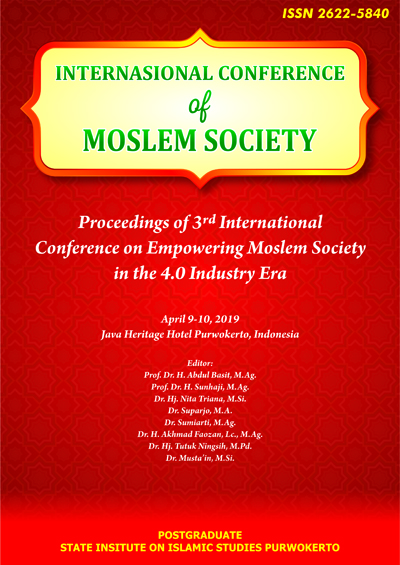Recognition of Community Environment: Character Education-Based Student Program
Looking at the Implementation of the PLM Program at SMAIT Al Irsyad Purwokerto
DOI:
https://doi.org/10.24090/icms.2019.2478Keywords:
education; student programs; character educationAbstract
Education is a big investment for all people, especially for parents. It is important for parents to decide the best educational institutions for their children. They will ask their relatives, neighbors, or even internet. It is almost confirmed that the decisions the parents take for determining a certain school will bring out great expectations for their children, such as being excellent, religious, intelligent, having live skills and many more. Such great expectations above are indeed supposed to be parents’ visions, educators and even country. In the formulation of the Law on the National Education System states that the aims of the National Education are at developing learners’ potentials so that they become persons imbued with human values who are faithful and pious to one and only God; who possess morals and noble character; who are healthy, knowledgeable, competent, creative, independent; and as citizens, are democratic and responsible. The idealism of the National Education’s aims seems to be a Utopia after arising certain phenomena, like several teenagers who is still in student age involve promiscuity, drug abuse, pornography, gadget addiction and loss of respect for parents. Moreover, many cases of prosecutions to parents because the demand that is not granted. School that as one of the pillars of educations, besides family and society has the strategic position for resolving the such problems. The requirements of curriculum management, human resources, and characters building-based students’ programs urge to be carefully formulated and can be implemented. The paper describes the students’ program in the form of the introduction of society environment (PLM) that is held by Al Irsyad Islamic Senior High School of Purwokerto. While there is a program called Community Service Program (KKN) in higher education, it is likewise the program in this school named Introduction of Society Environment (PLM). The program is attractive because it contains many values related to the characters building reinforcements. At least there are nine characters that can be built through this program, such as religious, tolerance, discipline, hard work, nationalism, loving country, being communicative, social and community care. The activities that carried out in the program are the repair of house and mosque, the clothes and staple foods distribution, the SMAIT teaching, the great recitation and free medical treatment. Keywords: education, students’ program, and characters buildingDownloads
References
Abdul Majid & Dian Andayani, Pendidikan Karakter Perspektif Islam (Bandung: PT Rosdakarya, 2012)
Darmiyati Zuhdi, Pembentukan Sikap, Cakrawala Pendidikan Journal Number 3, Year XlV, November 1995
Ira M. Lapindus, Kamus Umum Bahasa Indonesia (Jakarta: balai Pustaka, 1982)
Masnur Muslich, Pendidikan Karakter Menjawab Tantangan Krisis Multidimensional (Jakarta: Bumi Aksara, 2011)
Moh. Haitami Salim, Pendidikan Agama Dalam Keluarga Revitalisasi Peran Keluarga dalam Membangun Generasi Bangsa yang Berkarakter, (Yogyakarta: Ar-Ruzz Media, 2013)
Mohammad Nasirudin, Pendidikan Tasawuf, (Semarang: RaSAIL Media Group)
Muchlas Samani dan Hariyanto, Konsep dan Model Pendidikan Karakter, (Bandung: PT Remaja Rosda Karya, 2011)
Muhammad bin ‘Isa At Tirmidzi, Jami’ Tirmidzi, nomor hadits 1426, see Nasai, sunan kabir, hadith number 7251
Muhammad Japar, Suhadi, Desca Paridana Faculty of Social Science, Jakarta State University, Jurnal Pendidikan dan Ilmu Sosial, Vol. 28 No. 1 Juni 2018
National Character-Building Policy year 2010 – 2025
National Education Ministry of Indonesia, National Character-Building Policy year 2010 – 2025
National Education Ministry, Pedoman Pelaksanaan Pendidikan Karakter (2011), Center for Curriculum of National Education Department
Raharjo, Pendidikan Karakter sebagai Upaya Menciptakan Akhlak Mulia, dalam Jurnal Pendidikan dan Kebudayaan, (Jakarta: Balitbang Kemendiknas, Vol. 16 No. 3 Mei 2010)
Sri Wahyuni dan Abd. Syukur Ibrahim, Perencanaan Pembelajaran Bahasa Berkarakter, (Bandung: Refika Aditama, 2012)
Syamsu Yusuf LN, Psikologi Perkembangan Anak dan Remaja, (Bandung: PT Remaja Rosdakarya, 2008)
The Act of The Republic of Indonesia Number 20 Year 2003 on National Education System, Article 3 National Education Ministry of Indonesia
Zubaedi, Desain Pendidikan Karakter Konsepsi dan Aplikasinya dalam Lembaga Pendidikan, (Jakarta: Kencana, 2011)
Downloads
Published
How to Cite
Issue
Section
License
Copyright (c) 2019 Rofik Anhar

This work is licensed under a Creative Commons Attribution-ShareAlike 4.0 International License.
Authors who publish with this journal agree to the following terms:
- Authors retain copyright and grant the journal right of first publication with the work simultaneously licensed under a Creative Commons Attribution-ShareAlike 4.0 License that allows others to share the work with an acknowledgement of the work's authorship and initial publication in this journal.
- Authors are able to enter into separate, additional contractual arrangements for the non-exclusive distribution of the journal's published version of the work (e.g., post it to an institutional repository or publish it in a book), with an acknowledgement of its initial publication in this journal.
- Authors are permitted and encouraged to post their work online (e.g., in institutional repositories or on their website) prior to and during the submission process, as it can lead to productive exchanges, as well as earlier and greater citation of published work (See The Effect of Open Access).


